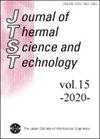翅片波纹和管形对翅片管式热交换器空侧性能的影响。第1部分干表面
IF 0.9
4区 工程技术
Q3 THERMODYNAMICS
引用次数: 0
摘要
对于建筑空调系统的冷却或加热盘管,通常使用大直径管(超过12.7 mm)带波翅片。此外,有人尝试将椭圆形管应用于加热或冷却盘管。本研究在干燥条件下对3个人字形波鳍/圆管、3个光滑波鳍/圆管和3个光滑波鳍/椭圆管样品进行了测试。所有样品具有相同的原始管径(12.7 mm)。对于光滑波鳍样品,翅片相同,对于圆管样品,翅片波纹角几乎相同。对锋面气流速度在1.0 ~ 4.0 m/s范围内进行了试验。结果表明,圆管样品的单位体积电导比椭圆管样品高。同样,光滑波鳍样品比人字波鳍样品产生更高的单位体积电导。然而,在同一排构型下,样品之间的单位体积传热导和换热系数存在显著差异,其原因可以用圆形和椭圆形几何形状的翅片效率差异来解释。圆形管样品的压降大于椭圆形管样品的压降。同样,光滑波鳍样品比人字波鳍样品产生更大的压降。性能评估表明,在相同的泵送功率下,光滑波鳍样品的单位体积换热系数大于人字波鳍样品。本文章由计算机程序翻译,如有差异,请以英文原文为准。
Effects of fin corrugation and tube geometry on the airside performance of fin-and-tube heat exchangers - Part I; dry surface
For a cooling or heating coil of a building air conditioning system, large diameter tubes (over 12.7 mm) with wave fins are frequently used. Furthermore, there have been attempts to apply oval tubes to the heating or cooling coils. In this study, nine samples - three herringbone wave fin/round tube, three smooth wave fin/round tube and three smooth wave fin/oval tube samples – were tested under dry condition. All of the samples had the same original tube diameter (12.7 mm). For the smooth wave fin samples, fins were identical, and for the round tube samples, fin corrugation angles were almost the same. Tests were conducted varying the frontal air velocity from 1.0 to 4.0 m/s. Results showed that the round tube samples yielded higher conductance per volume ( ) than the oval tube sample. Similarly, the smooth wave fin samples yielded a higher conductance per volume than the herringbone wave fin samples. At one row configuration, however, a significant difference among samples existed between the heat transfer conductance per volume and the heat transfer coefficient, and the reason was explained by the difference in fin efficiency between the round and the oval geometry. The pressure drops of the round tube samples were larger than those of the oval tube samples. Similarly, the smooth wave fin samples yielded larger pressure drops than the herringbone wave fin samples. A performance evaluation revealed that the smooth wave fin samples yielded larger heat transfer conductances per volume than the herringbone wave fin samples at the same pumping power per volume.
求助全文
通过发布文献求助,成功后即可免费获取论文全文。
去求助
来源期刊
CiteScore
2.30
自引率
8.30%
发文量
0
审稿时长
5 months
期刊介绍:
JTST covers a variety of fields in thermal engineering including heat and mass transfer, thermodynamics, combustion, bio-heat transfer, micro- and macro-scale transport phenomena and practical thermal problems in industrial applications.

 求助内容:
求助内容: 应助结果提醒方式:
应助结果提醒方式:


